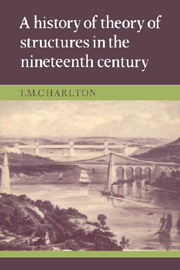Book contents
- Frontmatter
- Contents
- Preface
- 1 Introduction
- 2 Beam systems
- 3 Theory of the arch and suspension bridge
- 4 Elementary theory of frameworks: graphical statics
- 5 Theory of statically-indeterminate frameworks: the reciprocal theorem
- 6 Levy's theory of frameworks and bridge girders
- 7 Early developments of energy principles relating to theory of structures
- 8 The later development and use of energy principles
- 9 Applications of the least work principle: elastic theory of suspension bridges
- 10 Aspects of the further development of theory of structures
- 11 Secondary effects in structures
- Appendices
- Bibliography
- Name index
- Subject index
5 - Theory of statically-indeterminate frameworks: the reciprocal theorem
Published online by Cambridge University Press: 18 September 2009
- Frontmatter
- Contents
- Preface
- 1 Introduction
- 2 Beam systems
- 3 Theory of the arch and suspension bridge
- 4 Elementary theory of frameworks: graphical statics
- 5 Theory of statically-indeterminate frameworks: the reciprocal theorem
- 6 Levy's theory of frameworks and bridge girders
- 7 Early developments of energy principles relating to theory of structures
- 8 The later development and use of energy principles
- 9 Applications of the least work principle: elastic theory of suspension bridges
- 10 Aspects of the further development of theory of structures
- 11 Secondary effects in structures
- Appendices
- Bibliography
- Name index
- Subject index
Summary
The precise analysis of statically-indeterminate systems of bars, including trusses and pin-jointed frameworks generally, seems to be due to the famous French engineer, Navier. It was included in his lectures at l'Ecole des Ponts et Chaussées, which appeared in the form of his celebrated Leçons in 1826. According to Saint-Venant (Navier, 1864, p. 108) the method was part of the course as early as 1819. It was elaborated (1862) by the mathematician Clebsch in Germany; while, in Britain, Maxwell (1864b) who, it seems, was unaware of Navier's elegant and general method, published an original method of solving the problem. Levy, who was apparently aware of Navier's work, published a novel method in 1874 (Chapter 6). But it was not really until the German engineer, Mohr, published his analysis in the same year that the subject began to be appreciated by engineers (on the Continent at first and much later in Britain).
This chapter is concerned with those original contributions, in principle only: various sophistications and devices to increase their utility in engineering are considered in Chapters 8 and 10.
Navier, 1826
Navier's contribution to the analysis of statically-indeterminate pin-jointed systems is to be found essentially in the two articles of his Leçons (1826, art. 632, p. 296; 1833, art. 533, p. 345).
Information
- Type
- Chapter
- Information
- Publisher: Cambridge University PressPrint publication year: 1982
